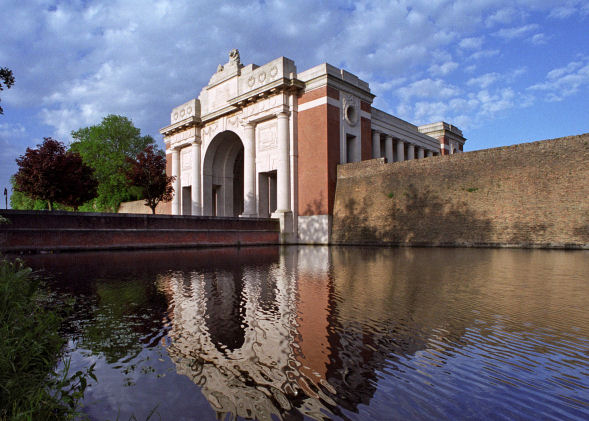Medal card : Pte., 25th London Regt.
Medal roll : 25th
London R. Pte., Attached Infantry Base Depot 1(a) France 21.7.17 to 8.8.17
Posted to 10th London R. 1(a) France 9.8.17 to 23.9.17., K.A. 23.9.17.
'Soldiers Died in the Great
War 1914-19' - under the heading
"25th (County of London) Battalion (Cyclists)" :-
Grist, Arthur Robert, born Deptford, resident Deptford,
enlisted Fulham, 742226, Cyc., killed in action, France & Flanders, 23
Sep 1917.
In Memory of
Private Arthur GRIST
742226, London Regiment (Cyclists) posted to 2nd/10th Bn., London Regiment
who died age 20 on 23 September 1917
Son of William and Charlotte Grist, of 281, Evelyn St., Deptford, London.
Remembered with honour Ypres (Menin Gate) Memorial, Panel
54.

Commemorated in perpetuity by
the Commonwealth War Graves Commission
Yypres (Menin Gate) Memorial,
Ieper
,
West-Vlaanderen
,
Belgium
The Menin Gate is one of four memorials to the
missing in Belgian Flanders which cover the area known as the Ypres
Salient. Broadly speaking, the Salient stretched from Langemarck in the
north to the northern edge in Ploegsteert Wood in the south, but it varied
in area and shape throughout the war. The Salient was formed during the
First Battle of Ypres in October and November 1914, when a small British
Expeditionary Force succeeded in securing the town before the onset of
winter, pushing the German forces back to the Passchendaele Ridge. The
Second Battle of Ypres began in April 1915 when the Germans released
poison gas into the Allied lines north of
Ypres
. This was the first time gas had been used by either side and the
violence of the attack forced an Allied withdrawal and a shortening of the
line of defence. There was little more significant activity on this front
until 1917, when in the Third Battle of Ypres an offensive was mounted by
Commonwealth forces to divert German attention from a weakened French
front further south. The initial attempt in June to dislodge the Germans
from the Messines Ridge was a complete success, but the main assault
north-eastward, which began at the end of July, quickly became a dogged
struggle against determined opposition and the rapidly deteriorating
weather. The campaign finally came to a close in November with the capture
of Passchendaele. The German offensive of March 1918 met with some initial
success, but was eventually checked and repulsed in a combined effort by
the Allies in September. The battles of the Ypres Salient claimed many
lives on both sides and it quickly became clear that the commemoration of
members of the Commonwealth forces with no known grave would have to be
divided between several different sites. The site of the Menin Gate was
chosen because of the hundreds of thousands of men who passed through it
on their way to the battlefields. It commemorates those of all
Commonwealth nations, except
New Zealand
, who died in the Salient, in the case of
United Kingdom
casualties before 16 August 1917 (with some exceptions). Those
United Kingdom
and
New Zealand
servicemen who died after that date are named on the memorial at Tyne Cot,
a site which marks the furthest point reached by Commonwealth forces in
Belgium
until nearly the end of the war. Other
New Zealand
casualties are commemorated on memorials at
Buttes
New
British
Cemetery
and
Messines
Ridge
British
Cemetery
. The
YPRES
(MENIN GATE) MEMORIAL now bears the names of more than 54,000 officers and
men whose graves are not known. The memorial, designed by Sir Reginald
Blomfield with sculpture by Sir William Reid-Dick, was unveiled by Lord
Plumer on 24 July 1927.
Ypres (now
Ieper
) is a town in the
Province
of
West Flanders
. The Memorial is situated at the eastern side of the town on the road to
Menin (Menen) and Courtrai (
Kortrijk
). Each night at 8 pm the traffic is stopped at the Menin Gate while
members of the local Fire Brigade sound the Last Post in the roadway under
the Memorial's arches.
[Courtesy of
Commonwealth War Graves Commission]
|